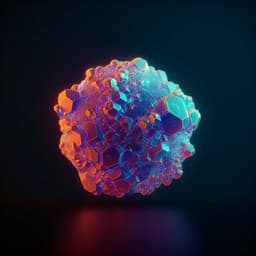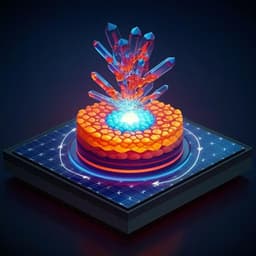
Engineering and Technology
Photon shifting and trapping in perovskite solar cells for improved efficiency and stability
S. Haque, M. Alexandre, et al.
Explore groundbreaking advancements in solar technology with Sirazul Haque and colleagues, as they unveil a novel checkerboard pattern for perovskite solar cells that boosts efficiency through innovative UV photon conversion. Discover how their research paves the way for enhanced performance and stability in space applications!
~3 min • Beginner • English
Introduction
Perovskite-based materials have been a central focus of research in highly efficient photovoltaic (PV) technologies. Their exceptional optoelectronic properties enabled perovskite-based solar cells to achieve remarkable growth in power conversion efficiency (PCE) in 12 years, going from 3.8% to 26.1%, which is comparable to the efficiency of contemporary commercial c-Si solar cells. Most importantly, perovskite solar cells (PSCs) have the potential to become the low-cost market leader in consumer-oriented solar-powered systems (EVs, BIPV, portable electronics, IoT, etc.) if their lifetime can be increased from around one year to 15+ years. Nevertheless, the lifetime of PSCs is affected by extrinsic (environmental) and intrinsic factors. Environmental factors such as moisture and oxygen can be solved by encapsulation, whereas intrinsic factors, such as hygroscopicity, thermal stress, and ion migration, lead to instabilities within the perovskite bulk material and its interface to the charge transport layers.
UV degradation, for instance, is one of the most detrimental intrinsic factors as it leads to irreversible degradation of perovskites upon formation of I2 or polyiodide I3. Such issue becomes particularly critical in the realm of new Space applications, where the paramount irradiation test for devices revolves around their resilience to UV exposure. This is especially crucial due to the exceptionally high levels of UV radiation encountered under AMO conditions. The degradation is typically triggered by interfacial photocatalytic reactions between electron transport layer (ETL) in high-performing PSCs and the perovskite film. This photostability problem can be easily solved if UV radiation does not reach the interface of ETL/perovskite layers. However, by using a UV-shielding encapsulant layer in PSCs, the UV photon of the solar spectrum will be lost, hence limiting further efficiency gains. Recently, there has thus been an increasing trend towards engineering a layer that not only functions as an encapsulant, but also as a photon-recycler for the incident UV light.
By adding luminescent down-shifting (LDS) fluorophores to the encapsulant layer, one can protect the PSCs from environmental factors and convert high energy photons into lower energy ones. These lower energy photons can then be absorbed by the perovskite layer without issues, and the increased number of visible photons available for absorption by the cell will in turn increase the external quantum efficiency (EQE) of the PSC. Among distinct luminescent materials, such as organic dyes, quantum dots (QDs), and lanthanide metal ions/complexes, the lanthanide-based beta-diketonate complexes stand out. The well-known Ln3+ luminescence sensitization, or antenna effect, can be used as an efficient light-conversion molecule. The ligand-induced large Stokes' shift and the ligand-to-Ln3+ energy transfer processes ensure an efficient UV-downshifted emission towards the visible spectral range. Lanthanide (Ln3+) based materials, such as Eu or Tb, have shown significant potential for acting as UV absorbers in the 300 to 400 nm wavelength region, and for efficiently shifting these impinging photons into useful lower-energy photons in the visible region. In addition, the LDS layers composed of such Eu3+ and Tb3+ materials manifest stronger ligand-induced Stokes shifts compared to other LDS materials, such as organic dyes or QDs, thus posing smaller losses from self-absorption. LDS layers made of doped organic-inorganic hybrid materials with Eu3+ and Tb3+ have already been implemented on PV devices; for instance, c-Si-based PV cells displayed an absolute EQE increase of ~27%. Recently LDS materials have also been applied in PSC technology to improve the PV response while protecting the cells from UV-induced degradation. In particular, Rahman et al. demonstrated a ~14% enhancement of PCE in PSCs in combination with improved device stability by using LDS layers composed of Eu3+.
Enhancing the material quality of perovskite PV to improve carrier mobility and minimize defect density is another crucial aspect for achieving high performance. One way to reduce bulk recombination is to reduce the thickness of the active layer. Yet, thin absorbers suffer from reduced light absorption, hence limiting their efficiency. Advanced light-management techniques, particularly light-trapping (LT) solutions, can offer a promising solution to increase the optical path within the active layer and thereby absorb more light.
Light trapping serves as a key strategy to attain physically thin but optically thick absorbers that not only results in mutual benefits for both optical and electrical properties, but also reduces material consumption (especially hazardous/toxic elements, such as Pb, present in common perovskite compositions) and fabrication costs. This LT strategy may even lead to the increased mechanical bendability of the devices.
Recent studies have highlighted the particularly promising potential of simple grating structures for LT in PSCs. They have also been shown to achieve photo-current enhancements in thin-film c-Si comparable to more complex photonic strategies like quasi-random super-cell structures. These structures may result from the displacement and rotation of periodic grating lines, yielding a trellis pattern that resembles a checker-board. One notable advantage of periodic grating lines is their industrial-friendly integration, which is conducive to large-scale applications. This makes them highly appealing for practical implementation in the manufacturing of PSCs, as they offer a feasible and scalable approach to enhance light absorption and boost the overall performance of the cells. As such, using a simple trellised structure represents a promising avenue for advancing the PSCs design and unlocking their full potential for efficient and cost-effective solar energy harvesting.
By endowing PSCs with robust encapsulant properties and advanced light-management architectures, new areas of application open up for this PV technology. Among the most relevant areas are Space applications, where PSCs can be a viable alternative to the III-V multi-junction solar cells (CdTe, GaAs, CIGS) commonly used in this field, owing to their potential for high efficiency at a lower weight and cost. The lightweight and flexible nature of PSCs can reduce the overall weight of solar panels, which is critical for Space missions. Furthermore, the potential for high power-to-weight ratio and flexibility of PSCs offers new opportunities for innovative design and integration in Space systems. For instance, their thin-film nature and solution processability allows for conformal coating on various substrates, such as flexible and curved surfaces, which can enable novel solar panel configurations and maximize the use of sunlight-exposed surfaces on satellites and spacecraft. Moreover, some of the environmental stressors that reduce the lifetime of the PSCs are attenuated in Space where oxygen and moisture barely exist. What's more, PSCs have shown remarkable radiation tolerance and self-healing capabilities, with studies demonstrating that they can maintain their high efficiency even after exposure to high doses of radiation.
This work now demonstrates a novel strategy for significantly boosting the sunlight-to-electricity conversion of PSCs while greatly improving their UV stability and flexibility. To achieve that, coupled optical and electrical modeling, grounded on experimental results, was employed to explore a combination of two unprecedented optical approaches in PSCs: constructing a distinctive photonic checkerboard design for LT combined with photon down-shifting. First, the checkerboard (CB) gratings were arranged with symmetry-property and optimized for integration as an LT structure for PSCs. Secondly, we studied the coupling of the optimized CB photonic front structure with an LDS encapsulant material composed of an experimentally developed tri-ureasil modified by lanthanides (t-U (5000)/Eu3+). Both approaches lead to substantial performance improvements in PSCs. Aside from significant photocurrent enhancement, the LT-enhanced ultrathin PSCs showed improved open-circuit voltage and fill factor, resulting in a significant PCE enhancement of 28%. Subsequently, it was found that the investigated LDS layer blocks nearly 94% of the total UV radiation in the 300-400 nm spectral region, re-emitting it into the visible spectrum, which translates to electrical gains for the PSC. This combined optical strategy in PSCs not only opens up a wide range of PSC applications in consumer electronics devices, but it also bodes well for the next generation of high-efficiency Space solar technology.
Literature Review
Methodology
- Device architectures: Two perovskite solar cell (PSC) configurations were considered: (1) a planar reference stack with planar ITO and TiO2 layers; (2) a photonic-enhanced stack where periodic grating lines arranged in a trellised checkerboard (CB) pattern are implemented in the TiO2 electron transport layer (ETL) on the front contact. The stack includes ITO (TCO), TiO2 (ETL), perovskite absorber (250 nm or 500 nm thickness), Spiro-OMeTAD (HTL), and Ag back contact. The CB structure is top-coated to avoid patterning the perovskite absorber.
- Geometric parameters and constraints: The CB geometry is described by etching depth (h), line width (w), grating period (g), and tile side length (l). Thicknesses of TCO, ETL, HTL, and Ag were constrained to fabrication-feasible values (per Table S1). TiO2 was chosen for ETL due to its refractive index aiding light trapping and its prevalent use in PSCs.
- Optical modeling: Rigorous 3D finite-difference time-domain (FDTD) simulations (ANSYS Lumerical FDTD) were used to compute spectral absorption in each layer and the spatial optical generation rate G(x,y,z). The global AM1.5 (and AM0 for Space scenarios) spectra were used; to include luminescent down-shifting (LDS), the incident spectrum was modified by the measured absorption and emission of the t-U(5000)/Eu3+ encapsulant, providing a photon flux incorporating LDS absorption in 300–400 nm and re-emission in the visible. Power absorption density maps P_ABS and angle-resolved unpolarized photocurrent density J_ph were computed for perovskite thicknesses of 250 nm and 500 nm.
- Optimization: A particle swarm optimization (PSO) routine searched the CB parameter space (h, w, g, l) to maximize photocurrent/absorption in the perovskite while minimizing reflection and parasitic absorption. The optimized CB yields broken symmetry and quasi-random-like diffraction for broadband light trapping and anti-reflection.
- Electrical modeling: The FDTD-derived G(x,y,z) served as input to a finite-element drift–diffusion solver (ANSYS Lumerical CHARGE) to compute J–V characteristics and extract J_sc, V_oc, fill factor (FF), and PCE. Simulations compared planar vs. LT-enhanced PSCs, with and without the LDS layer, and for both perovskite thicknesses. Band diagrams and carrier recombination/transport were analyzed to link optical gains to electrical performance.
- Fabrication considerations: Scalable fabrication routes for the CB include nanoimprint lithography, laser interference lithography (with contact mask and dual exposures), and displacement Talbot lithography (simultaneous exposure of orthogonal lines, relaxed mask requirements), supporting manufacturability without structuring the perovskite layer.
Key Findings
- Photocurrent and efficiency gains: Combined optical–electrical modeling predicts that the CB light-trapping structure increases photocurrent and power conversion efficiency (PCE) in ultrathin PSCs by 25.9% and 28.2%, respectively (abstract). LT-enhanced ultrathin PSCs also exhibit improved V_oc and FF, yielding an overall ~28% PCE enhancement.
- UV-to-visible conversion: The luminescent down-shifting (LDS) encapsulant t-U(5000)/Eu3+ effectively absorbs UV (300–400 nm) and re-emits in the visible, converting at least ~94% of incident UV photons into the visible spectral range, simultaneously acting as a UV shield to mitigate UV-induced degradation pathways at the ETL/perovskite interface.
- Light-trapping effectiveness across thicknesses: For perovskite thicknesses of 250 nm and 500 nm, the J_ph gain due to the LT CB structure is ~26% and ~19%, respectively. Thinner absorbers benefit more strongly from LT, particularly at wavelengths >600 nm where longer optical paths are needed.
- Reduced reflection and parasitic losses: Cumulative photocurrent analysis shows a marked reduction in overall reflection with LT: for 250 nm cells, reflection decreases from ~5 to ~2 mA cm^-2; for 500 nm cells, from ~3.7 to ~1.6 mA cm^-2. Absorption in perovskite exceeds 80% across much of the visible.
- Broadband and angular response: The optimized CB pattern provides anti-reflection, strong in-coupling, and oblique diffraction increasing optical path length, delivering broadband absorption enhancement and increased angle-resolved J_ph relative to planar cells over a wide incidence range.
- Manufacturability: The CB trellis of periodic grating lines is compatible with scalable, low-cost lithographic methods (e.g., nanoimprint, DTL), supporting industrial integration.
Discussion
The study addresses two critical challenges for perovskite solar cells: maintaining high optical absorption in thin absorbers and mitigating UV-induced degradation. The optimized checkerboard (CB) photonic structure enhances broadband light trapping through anti-reflection, strong in-coupling, and oblique diffraction, increasing absorption particularly in the 600–800 nm range where thin perovskites typically underperform. When these optical gains are translated through drift–diffusion modeling, they yield higher J_sc and, through reduced recombination in thinner, more optically effective absorbers, improvements in V_oc and FF, culminating in ~28% PCE enhancement.
In parallel, the t-U(5000)/Eu3+ LDS encapsulant functions as both a protective UV barrier and a photon recycler: it absorbs 300–400 nm radiation and re-emits in the visible where perovskites absorb efficiently, converting at least ~94% of incident UV into usable photons. This dual role protects interfaces prone to UV-triggered photocatalytic reactions while bolstering the photocurrent, thereby linking improved stability with performance gains.
Together, the CB LT and LDS strategies provide a synergistic route to thin, stable, and efficient PSCs. The approach is also well-suited to Space applications (AM0 spectrum), where UV flux is elevated and mass/area constraints favor thin, flexible, high power-to-weight devices. The manufacturable CB pattern further supports practical scalability for commercial implementation.
Conclusion
This work introduces a manufacturable checkerboard (CB) photonic front structure and a Eu3+-doped tri-ureasil [t-U(5000)/Eu3+] luminescent down-shifting (LDS) encapsulant to simultaneously enhance efficiency and UV stability of perovskite solar cells. Coupled FDTD optical and drift–diffusion electrical simulations show that: (i) ultrathin PSCs gain ~25.9% in photocurrent and ~28% in PCE via CB light trapping; (ii) the LDS encapsulant converts ~94% of incident UV (300–400 nm) to visible photons, protecting the device and boosting absorption in the perovskite.
These advances outline a photonic pathway to thin, efficient, and robust PSCs suitable for consumer and Space applications. Future work could experimentally realize and optimize the CB patterns with NIL/DTL, integrate and characterize the t-U(5000)/Eu3+ layer on PSC modules, quantify long-term UV stability under AM1.5 and AM0 conditions, and co-optimize LT and LDS parameters (geometry, concentration, emission spectra) for various perovskite bandgaps and tandem architectures.
Limitations
Related Publications
Explore these studies to deepen your understanding of the subject.







